Neuroscience For Kids
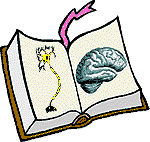 What Is Dyslexia?
What Is Dyslexia?
![]() The term "dyslexia" was coined by Rudolf Berlin of Stuttgart, Germany, in
1887. He used this word to describe reading difficulties that students
had with words and letters. The American Heritage Dictionary
defines dyslexia as "a learning disability marked by impairment in the
ability to read." More recently, dyslexia has been defined as "the
inability to learn to process written language despite adequate
intelligence, sensory ability, and exposure" (Grubin 2002).
The term "dyslexia" was coined by Rudolf Berlin of Stuttgart, Germany, in
1887. He used this word to describe reading difficulties that students
had with words and letters. The American Heritage Dictionary
defines dyslexia as "a learning disability marked by impairment in the
ability to read." More recently, dyslexia has been defined as "the
inability to learn to process written language despite adequate
intelligence, sensory ability, and exposure" (Grubin 2002).
Symptoms of Dyslexia
Common symptoms of dyslexia include, but are not limited to:
- Problems with spelling;
- Difficulty in recognizing individual sounds in words;
- Reading difficulties;
- Differences between a child's ability and his actual level of achievement;
- Difficulties in naming things;
- Problems with getting things in the right order.
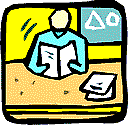 Just as every child is different, so are the
symptoms of dyslexia. Some children with children may show only one or
two of these signs, while others may have more.
Just as every child is different, so are the
symptoms of dyslexia. Some children with children may show only one or
two of these signs, while others may have more.
What Is Reading?
Reading is an interpretation of graphic symbols. Unlike learning to talk, however, learning to read is not natural. Children do not automatically learn to read -- they must be taught. For some children, the ability to break speech into its tiny parts, a task crucial in reading, is not easy. Brain research has begun to shed light on what is happening in the brains of children with dyslexia.
How Do Children Learn to Read?
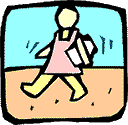 There are many theories as to how a child learns to read. Most theories
"assume that information is extracted from the stimulus (i.e. written
text) and mentally represented, and that this representation is used to
search one's memory for stored information about the stimulus" (Rapp
2001). Reading consists of a variety of behaviors, each of which uses
a different part of the brain:
There are many theories as to how a child learns to read. Most theories
"assume that information is extracted from the stimulus (i.e. written
text) and mentally represented, and that this representation is used to
search one's memory for stored information about the stimulus" (Rapp
2001). Reading consists of a variety of behaviors, each of which uses
a different part of the brain:
- Letter naming;
- Letter perception;
- Word recognition; and
- Comprehension.
According to Grubin (2002), "to read, the brain must cobble together a variety of parts that evolved for other purposes -- vision, hearing, judgment, and memory -- all of which come into play in a rapid-fire overlapping process that scientists are just beginning to understand."
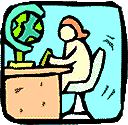 To learn to read, a child must first develop an
appreciation for the order of speech and the understanding that spoken
words are made up of the smallest of these segments, called
phonemes (Pugh et al. 2001). In other words,
learning to read requires that the student be able to break speech into
the individual components of language represented by letters and to be
able to tell the difference between the individual phonemes that make up
speech. Learning to read requires that the central principle behind the
alphabet is understood -- that is, words are made of phonemes and, in
print, phonemes are represented by letters (Brady et al. 1994).
"Phonemes are the shortest units of sound that can be uttered in a given
language and that can be recognized as being distinct from other sounds in
the language" (Drubach 2000). For example, the word cat has three
phonemes: ca, ah, and ta. Before children can learn to read, they must
be aware that words are made up of sounds and that letters represent these
sounds, or phonemes (Pugh et al. 2001; Drubach 2000; D'Arcangelo 1999).
So, how does this happen? How do children learn to recognize phonemes?
What happens in the brain when a child reads a word?
To learn to read, a child must first develop an
appreciation for the order of speech and the understanding that spoken
words are made up of the smallest of these segments, called
phonemes (Pugh et al. 2001). In other words,
learning to read requires that the student be able to break speech into
the individual components of language represented by letters and to be
able to tell the difference between the individual phonemes that make up
speech. Learning to read requires that the central principle behind the
alphabet is understood -- that is, words are made of phonemes and, in
print, phonemes are represented by letters (Brady et al. 1994).
"Phonemes are the shortest units of sound that can be uttered in a given
language and that can be recognized as being distinct from other sounds in
the language" (Drubach 2000). For example, the word cat has three
phonemes: ca, ah, and ta. Before children can learn to read, they must
be aware that words are made up of sounds and that letters represent these
sounds, or phonemes (Pugh et al. 2001; Drubach 2000; D'Arcangelo 1999).
So, how does this happen? How do children learn to recognize phonemes?
What happens in the brain when a child reads a word?

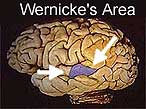 When a person reads, his brain coordinates a complex series of
responses. The brain begins by directing attention to the reading task
itself. This activity occurs in the prefrontal lobe of the cerebral
cortex. The prefrontal lobe is located just behind the forehead and is
largely responsible for higher-order thinking and problem-solving. The
brain then captures a visual representation of the printed letter(s) in
the primary visual area of the occipital lobe. A signal is then
transmitted from the occipital lobe to the angular gyrus where the visual
symbol is linked up to the letter's corresponding sound and meaning in
a specialized language area of the brain called Wernicke's area.
When a person reads, his brain coordinates a complex series of
responses. The brain begins by directing attention to the reading task
itself. This activity occurs in the prefrontal lobe of the cerebral
cortex. The prefrontal lobe is located just behind the forehead and is
largely responsible for higher-order thinking and problem-solving. The
brain then captures a visual representation of the printed letter(s) in
the primary visual area of the occipital lobe. A signal is then
transmitted from the occipital lobe to the angular gyrus where the visual
symbol is linked up to the letter's corresponding sound and meaning in
a specialized language area of the brain called Wernicke's area.
What Happens in the Brains of Children with Dyslexia?
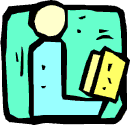 For some children, the ability to break speech into its tiny parts is not
easy. These children are among the millions with dyslexia. Children with
dyslexia, despite adequate intelligence, have trouble understanding that a
single word may be made of several different sounds. For example, the
word cat has three distinct phonemes: ca, ah, and ta. When we speak, we
blend the sounds together and say them as one: "cat." Growing up, a
child hears and says the word c-a-t as one sound, cat. When it comes time
to learn to read, a child must learn that there are three separate sounds.
This is difficult for children with dyslexia. The inability to break
speech into its parts is the main reason why children with dyslexia have
trouble learning to read.
For some children, the ability to break speech into its tiny parts is not
easy. These children are among the millions with dyslexia. Children with
dyslexia, despite adequate intelligence, have trouble understanding that a
single word may be made of several different sounds. For example, the
word cat has three distinct phonemes: ca, ah, and ta. When we speak, we
blend the sounds together and say them as one: "cat." Growing up, a
child hears and says the word c-a-t as one sound, cat. When it comes time
to learn to read, a child must learn that there are three separate sounds.
This is difficult for children with dyslexia. The inability to break
speech into its parts is the main reason why children with dyslexia have
trouble learning to read.
 Some evidence suggests that the brains of children with
dyslexia work differently than those in other children. Although the
specific brain areas involved with dyslexia are still uncertain, many
researchers suspect that the brain areas controlling language,
particularly the angular gyrus, play a critical role
(Ariniello 1999). Research by Pugh et al. (2001) found that
reading-disabled children had dysfunctions in the posterior areas of their
left hemispheres. Similar findings are echoed by Sally Shaywitz, a
professor of Pediatrics at Yale University School of Medicine. According
to Shaywitz: "Good readers have a pattern of activation in the back of
the brain -- the system that includes the occipital region, which is
activated by the visual features of the letters; the angular gyrus, where
print is transcoded into language; and Wernicke's region, the area of the
brain that accesses meaning. This posterior area is strongly activated in
good readers, but we saw relative underactivation in poor readers"
(D'Arcangelo 1999).
Some evidence suggests that the brains of children with
dyslexia work differently than those in other children. Although the
specific brain areas involved with dyslexia are still uncertain, many
researchers suspect that the brain areas controlling language,
particularly the angular gyrus, play a critical role
(Ariniello 1999). Research by Pugh et al. (2001) found that
reading-disabled children had dysfunctions in the posterior areas of their
left hemispheres. Similar findings are echoed by Sally Shaywitz, a
professor of Pediatrics at Yale University School of Medicine. According
to Shaywitz: "Good readers have a pattern of activation in the back of
the brain -- the system that includes the occipital region, which is
activated by the visual features of the letters; the angular gyrus, where
print is transcoded into language; and Wernicke's region, the area of the
brain that accesses meaning. This posterior area is strongly activated in
good readers, but we saw relative underactivation in poor readers"
(D'Arcangelo 1999).
Do People with Dyslexia See Words Backwards? A Misconception About Dyslexia
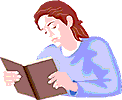 A common misconception about children (and adults) with dyslexia is that
they see letters and words backwards. According to Shaywitz (D'Arcangelo
1999), people with dyslexia do not have problems copying letters and
words. They may make some reversals in writing, but no more so than other
children. Problems arise when children with dyslexia are asked to read
what they just wrote, bringing the print to language. To use an example
given by Shaywitz, a child can copy the letters "w-a-s" correctly, but
when asked what was written, a child with dyslexia may reply "saw." The
problem is not one related to vision, but rather
one of "perceptual skills of what the child does with a word on a page...
Again, the brain mechanism of going from print to language is
phonologically based" (D'Arcangelo 1999).
A common misconception about children (and adults) with dyslexia is that
they see letters and words backwards. According to Shaywitz (D'Arcangelo
1999), people with dyslexia do not have problems copying letters and
words. They may make some reversals in writing, but no more so than other
children. Problems arise when children with dyslexia are asked to read
what they just wrote, bringing the print to language. To use an example
given by Shaywitz, a child can copy the letters "w-a-s" correctly, but
when asked what was written, a child with dyslexia may reply "saw." The
problem is not one related to vision, but rather
one of "perceptual skills of what the child does with a word on a page...
Again, the brain mechanism of going from print to language is
phonologically based" (D'Arcangelo 1999).
References and more information about dyslexia:
- Afifi, A..K. and Bergmann, R.A. (1998), Functional neuroanatomy. San Francisco: McGraw-Hill.
- Ariniello, L. (1999), Dyslexia and language brain areas. Society for Neuroscience Brain Briefings. Retrieved November 17, 2002 from http://apu.sfn.org/content/Publications/BrainBriefings/dyslexia.html.
- Brady, S. Fowler, A., Stone, B. and Winbury, N. (1994), Training phonological awareness: A study with inner-city kindergarten children. Annals of Dyslexia, 44:26-59.
- D'Arcangelo, M. (1999), Learning about learning to read: A conversation with Sally Shaywitz. Educational Leadership, 57:26-31.
- Dechant, E. and Smith, H. (1977), Psychology in teaching reading. (2nd ed.). Englewood Cliffs, NJ: Prentice-Hall, Inc.
- Drubach, D. (2000), The brain explained. Upper Saddle River, NJ: Prentice-Hall, Inc.
- Grubin, D. (Producer), (2002). The secret life of the brain. [Television series]. Alexandria, VA: Public Broadcasting Service.
- Kandel, E.R., Schwartz, J.H., and Jessell, T.M. (2001). Principles of Neural Science. (4th ed.). New York: McGraw-Hill.
- Kantrowitz, B. and Underwood, A. (Jan. 31, 2000). Millions of otherwise bright children struggle with words, but recent brain research show there's hope-if parents and teachers know what to look for; dyslexia and the new science of reading. Newsweek, 70-76.
- Oakhill, J. and Beard, R. (Eds.) (1999). Reading development and the teaching of reading. Malden, MA: Blackwell Publishers Inc.
- Pugh, K.R., Mencl, W.E., Jenner, A.R., Katz, L., Frost, S.J., Lee, J.R., Shaywitz, S.E., and Shaywitz, B.A. (Nov.-Dec. 2001). Neurobiological studies of reading and reading disability. Journal of Communication Disorders, 34(6). 479-92.
- Rapp, B., Folk, J., Tainturier, M-J. (2001). Word reading. In Rapp, B. (Ed) (2001). The handbook of cognitive neuropsychology: What deficits reveal about the human mind. (pp. 233-262). Philadelphia: Psychology Press.
Page prepared by Erin Hoiland, Neuroscience for Kids Consultant
Copyright © 1996-2008, Eric H. Chudler, University of Washington
